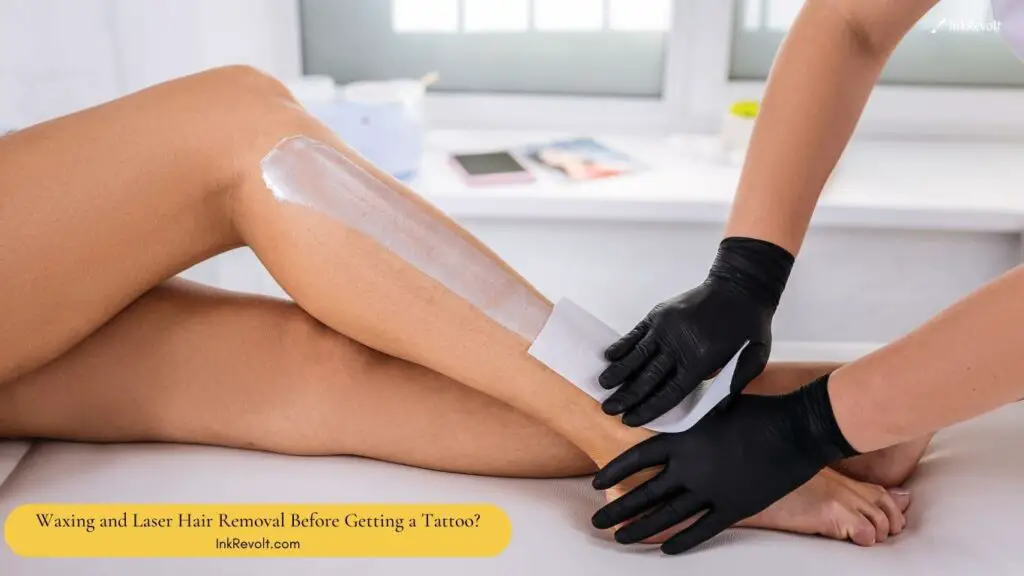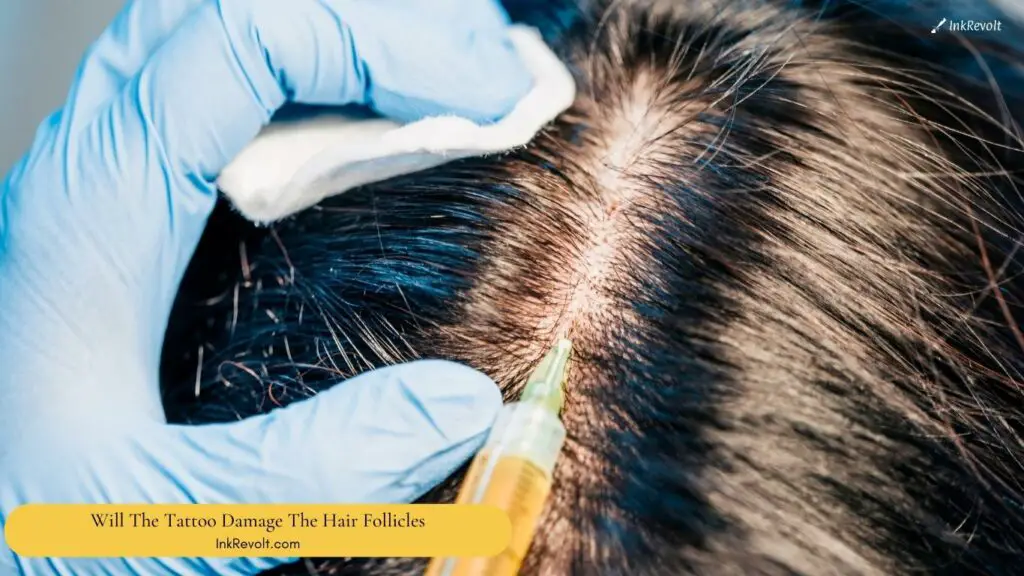What Happens If You Tattoo Over Hair?
When it comes to getting a tattoo on areas of the body that are covered in hair, such as the head, legs, or arms, it can raise some questions and concerns. If you are considering getting a tattoo over your hair, it is important to understand what happens during the process and what you can expect from the end result.
The hair can interfere with the ink and create a blurry or uneven tattoo. The hair follicles also contain oil and bacteria that can cause infections and irritation. In some cases, the hair can also be pushed out by the needle, causing the tattoo to heal poorly.
Additionally, the hair can absorb the ink, causing the tattoo to fade quickly. It’s recommended to shave the area before getting a tattoo to prevent these issues. However, if you already have a tattoo over your hair, it’s best to leave it alone and avoid adding more ink to the area.
In this article, we will take a closer look at what happens if you tattoo over your hair and what you need to know to make an informed decision. So stick around to learn more.

Why Shaving Before Tattoo Is Encouraged?
Shaving before getting a tattoo is encouraged for several reasons below.
Clearer lines: A shaved area will provide a clean surface for the tattoo artist to work on, which means the lines will be clearer and sharper.
Easier application: Hairs can get in the way while applying a tattoo, making the process uncomfortable and longer. Shaving eliminates this problem, making the tattoo application easier and quicker.
Better healing: Shaving helps to avoid skin irritation, itching, and infection during the healing process as hair follicles can trap bacteria and cause infection.
Better visibility: If a tattoo artist is working on an area with hair, it can be challenging to see the skin clearly and assess the shading, colour, and overall quality of the tattoo. Shaving makes it easier for the artist to see the skin and create a high-quality tattoo.
In conclusion, shaving before getting a tattoo is encouraged as it provides a clean surface, helps with the application process, aids in the healing process, and provides better visibility for the tattoo artist.
Things To Consider Before And After Shaving For A Tattoo
Shaving your hair before getting a tattoo is a common practice to prepare the skin for the tattooing process. It helps to create a clean and smooth surface for the tattoo artist to work on, ensuring the tattoo is precise and accurate.
However, there are a few things you should keep in mind before and after shaving your hair for a tattoo.
Before Shaving
- Make sure you are using a clean, sharp razor to avoid any infections or nicks in the skin.
- Ensure that you have sufficient growth in the area where you want the tattoo.
- If you have sensitive skin, it is advisable to apply a shaving cream or lotion before shaving to reduce any irritation.
After Shaving
- Avoid touching the shaved area with your hands to prevent any bacteria from spreading.
- Apply a moisturizer or lotion to the area to soothe any itching or redness.
- Avoid swimming, sun exposure, and other activities that may irritate the skin for at least 24 hours after shaving.
It is important to take proper care of your skin after shaving, as it will be more vulnerable to infections and irritations. Make sure to follow all aftercare instructions from your tattoo artist to ensure a successful and safe healing process.
What About Waxing and Laser Hair Removal Before Getting a Tattoo?

Waxing and laser hair removal are two common methods for hair removal that people use before getting a tattoo. Here is a detailed explanation of both methods and their implications before getting a tattoo.
Waxing:
Waxing involves using warm or cold wax to remove hair from the skin’s surface by pulling it out from the roots. Waxing can be done at home or by a professional in a salon. When waxing before getting a tattoo, it is recommended to do it at least 24 hours before the tattoo appointment to allow the skin to settle.
Advantages of waxing before getting a tattoo
- It helps to ensure that the skin is smooth and hair-free, which makes it easier for the tattoo artist to work.
- Waxing exfoliates the skin, removing any dead skin cells, which helps the tattoo to stand out and look more vibrant.
- Waxing can also help to reduce pain during the tattooing process by making the skin less sensitive.
Disadvantages of waxing before getting a tattoo
- Waxing can cause redness, swelling, and irritation, which can make it harder for the tattoo artist to work on the skin. It is recommended to avoid waxing if the skin is already irritated or sunburnt.
- Waxing can also leave the skin more sensitive to pain, making the tattooing process more uncomfortable.
Laser hair removal:
Laser hair removal is a more permanent method of hair removal that uses laser technology to target hair follicles and prevent hair growth. It is usually done by a professional in a clinic or salon, and multiple sessions are required for best results. Laser hair removal should be done at least four weeks before getting a tattoo to allow the skin to heal and settle.
Advantages of laser hair removal before getting a tattoo
- Laser hair removal is a more permanent method of hair removal, so there will be less need for hair removal in the future.
- Laser hair removal can help to exfoliate the skin, which can make the tattoo more vibrant and visible.
- Laser hair removal does not cause as much irritation to the skin as waxing.
Disadvantages of laser hair removal before getting a tattoo
- Laser hair removal can make the skin more sensitive, making the tattooing process more uncomfortable.
- Laser hair removal can cause skin irritation and redness, making it harder for the tattoo artist to work on the skin.
- Laser hair removal can also cause changes in the skin’s texture, which can affect the appearance of the tattoo.
Both waxing and laser hair removal can be done before getting a tattoo, but they both have advantages and disadvantages. It is essential to discuss with your tattoo artist which method is best for you and your skin type.
In general, it is best to avoid hair removal methods that can irritate the skin or make it more sensitive, as this can affect the quality of the tattoo.
Risks Of Doing Tattoo Over Hair

When a tattoo is done over hair, there are several potential consequences that can arise, both during and after the tattooing process. Here are some of the things that can happen:
- Irritation: The presence of hair can cause irritation to the skin during the tattooing process, particularly if the artist needs to go over the same area multiple times to achieve the desired effect.
- Infection: The risk of infection is higher when tattooing over hair, as bacteria can get trapped in the hair follicles and be more difficult to remove. It is important to keep the tattooed area clean and dry after the procedure to minimize the risk of infection.
- Difficulty in healing: Hair can also make it harder for the skin to heal properly after the tattoo is complete. The presence of hair can make it more difficult for the skin to form a scab, which can slow down the healing process and increase the risk of infection.
- Fading and distortion: Over time, the presence of hair can cause the tattoo to fade or become distorted. As the hair grows back, it can push against the ink and cause it to move or become less defined. This is particularly true for areas where the hair grows quickly, such as the scalp or face.
- Touch-ups: If the tattoo does fade or become distorted, touch-ups may be necessary. However, touch-ups can be more difficult to perform when the tattoo is done over hair, as the artist may need to work around the hair to achieve the desired effect.
While it is possible to tattoo over hair, it is important to consider the potential risks and consequences before doing so. If you are considering a tattoo in an area with hair, make sure to discuss your concerns with your tattoo artist and follow their aftercare instructions closely to minimize the risk of complications.
Can Hair Affect The Appearance Of Tattoos?
Yes, hair can affect the appearance of tattoos. Here are some ways how:
Hair Cover-up: Long hair can cover up the tattoos on the neck, arm or back, hiding the ink design and making it less noticeable. This can be an advantage for people who want to keep their tattoos hidden in certain situations.
Hair Style: Different hairstyles can also change the way tattoos look. For example, a buzz cut will make tattoos more noticeable and visible, whereas a long mane can conceal them.
Tattoo Placement: The placement of tattoos can also be influenced by hair. For example, if you have a lot of hair on your back, you may choose to get a tattoo on your ribcage, which is more visible.
Hair Color: Hair color can also affect the appearance of tattoos. For example, lighter hair may make tattoos more noticeable, whereas dark hair can conceal them.
Overall, hair can play a significant role in the appearance of tattoos. It’s important to consider your hair and how it may impact the visibility and aesthetic of your ink.
Will The Tattoo Damage The Hair Follicles?
The process of getting a tattoo involves the insertion of ink into the skin using a needle. The ink is deposited in the dermis, which is the second layer of skin, and does not reach the hair follicles. Hair follicles are located in the deeper layers of the skin and are not affected by the tattooing process.

However, in rare cases, if the needle is inserted too deeply, it could potentially cause damage to the hair follicles, leading to hair loss or patchiness. This is more likely to occur when getting a tattoo in areas with a high density of hair follicles, such as the scalp.
Additionally, if the tattoo artist is not experienced or uses contaminated needles, there is a risk of infection which could also lead to hair loss.
Points to consider:
- Tattoo ink does not penetrate the skin deeply enough to reach the hair follicles.
- The process of tattooing does not involve any direct contact with the hair follicles, so it is unlikely to cause any damage.
- Hair follicles are located much deeper in the skin than the depth at which tattoo ink is deposited.
- However, if the skin around the hair follicles is irritated or traumatized during the tattooing process, it could lead to temporary hair loss in that area.
- In rare cases, if the hair follicles are directly punctured during the tattooing process, it could cause permanent hair loss in that area.
Overall, tattooing is unlikely to cause any lasting damage to the hair follicles, but it is important to consider the potential for temporary hair loss or irritation if the skin around the hair follicles is affected during the process.
What About Shaving After the Tattoo?
Shaving after getting a tattoo can be a concern for many people. The skin is usually sensitive and healing after getting a tattoo, so shaving too soon after the tattoo can increase the risk of infection and slow down the healing process. It is advisable to wait at least 2 weeks after getting a tattoo before shaving over the area.
If you must shave sooner, it’s important to take precautions to avoid damaging the skin.
- Make sure to use a clean and sharp razor, and avoid shaving over the tattooed area. Instead, shave around the area to minimize the risk of irritation.
- Also, use shaving cream or gel to reduce friction and avoid pulling on the skin.
- After shaving, it is essential to keep the skin moisturized and clean to help with the healing process. Use a fragrance-free lotion or ointment to keep the skin hydrated and avoid using any products that may cause irritation or redness.
In conclusion, while shaving after a tattoo is possible, it is best to wait until the skin has fully healed. When shaving, take precautions to avoid damaging the skin and be mindful of the healing process.
Frequently Asked Questions (FAQ)
Will The Hair Grow Back After Tattoo Removal?
Hair may or may not grow back after tattoo removal. This depends on various factors such as the location of the tattoo, the method used for removal, and the individual’s skin type and hair growth patterns. In some cases, hair may not grow back in the same location due to damage to the hair follicles caused by the tattoo removal process. In other cases, hair may grow back as normal.
Will The Hair Grow Back Thicker After The Tattoo?
No, hair will not grow back thicker after a tattoo. The hair growth process is not affected by the tattoo process and the thickness of the hair will remain the same.
Will The Tattoo Damage The Hair Follicles?
No, getting a tattoo does not usually damage the hair follicles. The needle used in tattooing only penetrates the top layer of skin and does not reach the hair follicles. However, in rare cases, some individuals may experience an allergic reaction to the ink or other components of the tattooing process that can cause damage to the skin and hair follicles.
Last Thoughts
Have you found a solution to the question “What happens if you tattoo over your hair?”
Now that we’ve covered everything there is to know about the issue, we hope you’re replying yes. tattooing over hair can have various outcomes depending on the type of hair, the location of the tattoo, and the artist’s technique. In general, tattooing over hair can cause discomfort and potential fading, as the hair can move during the healing process and cause the ink to blur.
However, with proper preparation, aftercare, and a skilled artist, it is possible to achieve successful tattoos over hair. Ultimately, it is important to consider the potential risks and weigh them against the desired results before making a decision to tattoo over hair.
